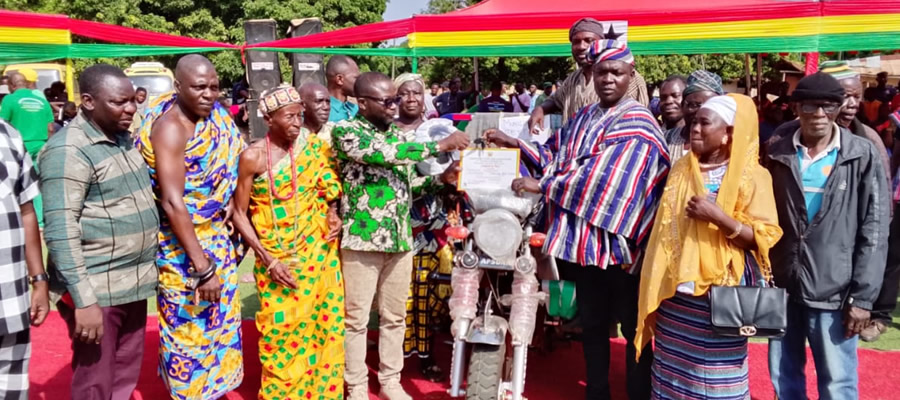

Introduction
Population size, composition and age-sex structure are important characteristics that have many social and economic implications. Population size and composition influence the district’s potential human resource requirement and level of provision of social services such as schools, hospitals/clinics and housing. With this in view, it is very important to know all the characteristics of the population we are planning for in terms of age distribution, population density and migration patterns in the Municipality. The changes in a country’s population are mainly through fertility, mortality and migration levels, which to a large extent, are influenced by age-sex composition. Chapter two discuss population size and distribution, age and sex structure, migration, fertility and mortality.
Population Size and Distribution
Population size
Brong Ahafo region recorded a population of 2,310,983 in 2010. Thus, the population increase annual growth rate of the region during the first two inter-censual period was followed by a decline in the subsequent inter-censual period. . The Kintampo North Municipality population stood at 95,480 comprising 47,302 (49.6%) male and 48,178 (50.4%) female. The Kintampo North Municipal has an estimated population density of 21.75 persons per square kilometre. This implies that there is no pressure on the land and the land is available for farming and other purposes.
Table 2.1 shows the population size and composition in Kintampo North Municipal. The table shows that, the total population of the municipal is 95,480 comprising of 47,302(49.6) for male population and 48,178(50.4%) for female population. The highest population is within the age-group 0-4 which is 14,625(15.32%) with 7,405 males and 7,220 females; this followed by age group 5-9 which is 13,400.
The male population for this group is 6,764 and 6,636 for female population. The age group 10-14 is the third highest in Kintampo North Municipal which stood at 12,481 with 6,413 for male population and 6,068 for the female population. It is observed that, the Municipal have to invest into putting up education, health and recreational facilities to cater for these categories of ages 0-14 so as to have productive youth population in future. The 90 and above recorded the least population in Kintampo North municipal with a total population of 168 .The trend is similar for both males and females which is 123 and 145.
The Municipality is slightly urban in nature than rural. The urban population is 51,212(56.8%) while the rural is 41,268(43.2%). Kintampo North Municipal is a transit point for persons travelling from southern to northern Ghana and vice versa as well as for international travellers from neighbouring West African countries. This probably explains why the urban population is higher than the rural in the Municipality.
Sex ratio
Sex ratio is the ratio of males to females in a given population, usually expressed as the number of males for every 100 females. Sex ratio at birth in most countries is about 105 or 106 males per 100 females. After birth, sex ratios vary because of different patterns of mortality and migration for males and females within the population. (Population Reference Bureau, 5th Edition).
Generally, there are more males than females at birth, but there are more male deaths at all ages. The sex ratio should therefore show a gradual decrease with age.It is observed that age 0-4 up to 15-19 have their sex ratio above 100. This shows an increasing trend from ages 0-4 to 15-19 with the exception age 5 to 9. Also ages 55-59 to 65-69 shows that sex ratio indicates a decreasing trend from the age 55-59 to 65 - 69 though it is above 100.The rest of the age brackets exhibits sex ratios less than hundred with the exception of ages 45-49 and 85-89 which is more than 100 in the Municipality.
Table 2.2 shows the population size by locality of residence and ratio. it also shows that the District has a ratio of 98.2 males per 100 females. Urban population have a sex ratio of 97.7 males’ per 100 females with rural population having a sex ratio of 113.7 males per 100 females. This implies that in the municipality there are more males than females in the rural settlements.
Age dependency ration
The dependency ratio is one of the key indicators of socio-economic development. This shows the age of persons in the “dependent” group (generally under age 15 and over age 64) to those in the “economically productive” ages (15-64 years) in a population. Countries with very high birth rates usually have the highest age-dependency ratios because of the large proportion of children in the population. (PRB-Population handbook, 5th Edition)
Table 2.3 shows the age-dependency ratio for Kintampo North Municipal is 88.21 in 2010 with child dependency ratio of about 79.8 and old age dependency ratio of 8.4. The regional total dependency ratio is 81.3, the child dependency ratio is 73.2 for the region and the aged is 8.1. This shows that the dependency ratio in Kintampo North Municipal is higher than the region. .
This means that in Kintampo North Municipal 88 persons in the dependent ages have to be supported by 100 persons in the economically productive ages.
Age-Sex Structure
The sex composition of a population is influence largely by the sex ratio at birth (ratio of male birth to female births) as well as sex differences in death rates and migration. For strategic planning to be effective there is the need to have the age and sex structure of the population. The age structure of a population affects a nation key socio economic issues. Countries with young populations (high percentage under age 15) need to invest more in schools, while countries with older populations (high percentage age 65 and over) need to invest more in the health sector. The age structure can also be used to predict potential political issues. For example, the rapid growth of a young adult population unable to find employment can lead to social vices like armed robbery, prostitution, alcoholism, to mention but a few. (Source: CIA World fact book).
Population pyramid
A population pyramid illustrates the age-sex structure of a country's population and may provide insights about the nature of dependency ratio as well as the social and economic structure of a country’s population in future. The shape of the population pyramid gradually evolves over time based on fertility, mortality, and international migration trends. (CIA World fact book). The population pyramids for developing Countries exhibit a triangular shape with a broad base and shrinks gradually upwards to a very tin top.
Figure 2.1 presents a population pyramid for Kintampo North Municipal. The shape of the pyramid is generally of a bell-shape with a broad base, which tapers off with increasing age. Ages 0-19, 30-79 which have larger male populations than females, except ages 20-29 with higher female population. . The age pattern of the pyramid is typical of most developing countries population age structure. Also less developed economies age-structure is characterized by a large proportion of children (<15 years) and a small proportion of elderly (64 years)
Fertility, Mortality and Migration
Fertility, mortality and migration are the three components of population change that determine the size, age-sex structure and distribution of the population at a particular point in time. Data on these three components are critical for planning the overall socio-economic development of the region. This chapter provides analysis of the fertility, mortality and migration patterns in the district.
Fertility
Measures of fertility are important in determining the size and structure of the population. Information on fertility in the region is, therefore, critical for the management of the population for social and economic development. This section reports on fertility, levels, patterns and trends.
Two types of fertility measures are used to examine levels and patterns of fertility. These are current fertility measures and cumulative fertility measures. Current fertility measures such as total fertility rate (TFR) are based on data covering a short period of time such as a year ( in the case of population censuses) or five years (in surveys), while cumulative measures such as mean children ever born are based on retrospective fertility data covering women’s reproductive performance over their lifetime.
The most commonly used measures of current fertility are the total fertility rate (TFR) and its component age-specific fertility rates (ASFR). The TFR is defined as the number of children a woman would have by the end of her childbearing years if she were to experience the currently observed age-specific fertility rates.
Fertility refers to the number of live births women have. It differs from fecundity, which refers to the physiological capability of women to reproduce. Fertility is directly determined by a number of factors that, in turn, are affected by a great many social, cultural, economic, health, and other environmental factors (Population Reference Bureau).
Two types of fertility data were collected: lifetime fertility and current fertility. Lifetime fertility refers to the total number of live births that females 12 years and older had ever had during their life time. Current fertility refers to the number of live births that females 12-54 years old had in the 12 months preceding the Census Night.Crude birth rate indicates the number of live births per 1000 population in a given year. General Fertility Rate is the number of live births per 1000 women ages 15-49 in a given year.
Table 2.4 shows the Reported Total Fertility Rates, General Fertility Rates and the Crude Birth Rates for the Brong Ahafo Region and Kintampo Municipality. The Municipal has a total population of 95,480 of which women ages 15-49 are 27,996 (29.3 %) of the total population.
The Total Fertility Rate for Kintampo North Municipal is about 3.9. General fertility rate is 115.1.1 live births per 1000 women, which is higher than the regional average of 105.9 births per 1,000 women which is higher than the regional average of 105.9 births per 1000 women. The crude birth rate of 27.8 births per 1000 population for the Municipal is also higher than the regional value of 26.3.
Table 2.5 shows female populations 12 years and older by age, with Children Ever Born (CEB) and Children Surviving (CS) by sex. The table further shows that, the Municipal has a total of 31,766 females aged 12 years and above with 89,691 CEB and 74,303 CS. For CEB 45,475 (50.7%) are males and 44,216 females (49.2%) whereas 37,181 (50.0%) of the CS are males and 37122 (49.9%) females. The age group 60+ has a higher proportion of 23.0 percent, followed by 13.3 percent for the 40-44 year age group of CEB. The 35-39 year age group has a proportion of 12.4 percent with the 30-34 year age group 11.9 percent. The 12-14 has the least proportion of 0.03 percent. The trend is similar for child surviving which has the least proportion (0.03%) between ages 12-14.
Migration
Migration is the geographic movement of people across a specific boundary for the purpose of establishing a new permanent or semi-permanent residence.
Table 2.6 shows the birthplace by duration of residence of migrants. It also indicates that a total of 37,388 migrants are resident in Kintampo North Municipal.The majority of the migrants are from the three northern regions totalling (45.7%) of the total resident migrants in the municipality. This can be attributed to the fertile land in the municipality. However, among the three northern regions, Northern region recorded the highest percentage (26.2%), of migrants in the municipality, followed by Upper West region (13.4%), and upper east recorded the least with (6.1%).
About 28 percent of the migrants have resided in the Municipal between 1-4years, 19 percent have resided between 10 and 19 years. Also, 17.4 percent for more than twenty (20+) years. Again, 18.4 percent of migrants have resided in the municipality for 5-9 years.
Table 2.6 further portrays an interesting migration pattern as larger proportions of the migrants from the three northern regions are more likely to reside between 1-4years. This can be attributed to the fertile nature of the land in the Municipal.
Mortality
Mortality refers to deaths that occur within a population. While we all die, the probability of dying during a given time period is linked to many factors, such as age, sex, race, occupation and social class. Mortality also plays an important role in determining the growth of a population. The level and pattern of mortality is a reflection of the health status of a population.
Results from mortality analyses underpin disease control programmes and in identifying viable health and related programmes which advance human survival. Mortality is measured by crude death rates which are affected by many population characteristics, particularly age structure. They are defined as the number of deaths per 1000 population in a given year and it measures the mortality experience in an entire population. Table 2.7 shows deaths in households and crude death rate for the Municipal. It further shows that a total of 673 death were recorded in 2010 with a crude death rate of about 7.0, thus in 2010 Kintampo Municipal had a crude death rate of about 7 per 1,000 population.
Age specific death rate
Age specific death rate is the number of death of people in a specified age group per 1000 population of that age group. Death rates can be analysed by age using age specific death rates. Because mortality varies greatly by sex and ethnicity, age-specific death rates are often given separately for males and females in a population. Figure 2.2 exhibits a u-shape. This shows clearly how death rate in the ages 0-4 is very high but declines as the ages increase above 0-4, it becomes stable for some time.
It also implies that at the old age of 70+ there is a rise in death rate. It is therefore necessary for policy intervention to at least reduce the death rate at ages 0-4 and 70+Figure 2.2 also shows that males in the 70 years and older age group has the highest death rate of 42.0 per 1000 population of that age, followed by the under 5 (18.9 per 1000 population) and the 50-54 year age group (15.1 per 1000 population). Female death rate is also high in the 70 year and older age group with 21.9 per 1000 population, followed by the 0-4 age group (16.6 per 1000 population and the 60-64 year age group 9.5 per 1000 population.
Date Created : 11/16/2017 7:26:22 AM












 facebook
facebook
 twitter
twitter
 Youtube
Youtube
 +233 593 831 280
+233 593 831 280 0800 430 430
0800 430 430 GPS: GE-231-4383
GPS: GE-231-4383 info@ghanadistricts.com
info@ghanadistricts.com Box GP1044, Accra, Ghana
Box GP1044, Accra, Ghana